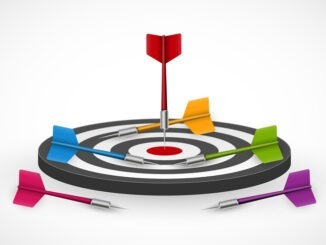
What is sales velocity and why is it of paramount importance for your B2B business?
CREDIT: This is an edited version of an article that originally appeared on Sales Readiness Group
Efficiently managing new sales opportunities and guiding them through the sales process is a vital distinction of top-notch sales teams. But how do you assess and enhance your team’s effectiveness? One answer lies in grasping the concept of sales velocity—a pivotal metric that unveils valuable insights into your sales team’s efficiency. Let’s delve deeper into its components and how you can leverage it to drive superior sales outcomes.
Understanding Sales Velocity
Understanding sales velocity empowers you to pinpoint areas for enhancement and make data-driven choices to expedite sales growth. Sales velocity consists of four key components:
Prospecting
Successful prospecting hinges on defining your company’s most valuable customer, the “ideal client profile” (ICP). Crafting your ICP necessitates a comprehensive assessment of factors to precisely identify prospects aligned with your offerings:
- Company Demographics: Scrutinize the fundamental demographic data of your most profitable customers. This encompasses industry verticals, company size in terms of employees or revenues, geographical locations, and unique attributes that enhance your solution’s appeal.
- Buyer Demographics: After identifying target businesses, evaluate individual buyer characteristics within these companies. Pay close attention to titles, seniority levels, organizational roles, and decision-making or budget authority.
- Likelihood of Engaging: Look for discernible trigger events like acquisitions, expansion plans, or sustainability initiatives that might make your solution more appealing. Additionally, consider previous engagement with your content, such as downloading whitepapers or attending webinars sponsored by your company.
Deal Size
Salespeople often feel compelled to pursue long-shot opportunities, diverting resources from more qualified prospects. To assess the value of a sales opportunity, consider two crucial questions:
- Is This Opportunity Worth Pursuing? Be brutally honest and acknowledge knowledge gaps. Evaluate criteria like revenue potential, profit potential, strategic value, and implementation risks.
- Can You Win? Assess your competitive position before investing resources in complex sales activities. Consider solution fit, business impact, and relationship strength with key decision-makers.
Conversion Rate
A high conversion rate translates to faster sales cycles, reduced cycle times, and increased revenue. It indicates your team’s proficiency in engaging prospects and effectively conveying your offerings’ value.
A low conversion rate signals potential sales process challenges. Identify root causes and implement targeted improvements for enhanced efficiency and effectiveness.
To optimize conversion rates, emphasize continuous improvement. Regularly evaluate your sales process, identify friction points in the customer journey, and invest in sales training and coaching programs to equip your representatives with essential prospect engagement skills.
Sales Cycle Length
Effective communication, streamlined processes, and efficient sales tools significantly impact sales cycle length. Monitoring and comprehending these factors are essential for optimizing the sales process and expediting deal closure. This includes assessing lead qualification, communication, and the decision-making process.
Optimizing the Sales Velocity Formula
Sales Velocity = Number of Opportunities x Average Deal Value x Win Rate / Sales Cycle Length
Let’s explore how to optimize the sales process to achieve high-velocity sales:
Number of Opportunities: Boosting qualified opportunities involves effective lead generation, targeted prospecting, and a deep understanding of the ideal customer profile. Focusing on high-quality leads maximizes efforts and enhances the likelihood of successful deal closures.
Average Deal Value: Analyse and optimize average deal values by understanding each customer’s revenue potential and prioritizing efforts accordingly. Consider factors like product configuration and pricing strategies to optimize your team’s sales approach.
Win Rate: Elevating the win rate necessitates a robust sales process, effective closing techniques, and thorough lead qualification. Track and analyse win rates to identify improvement areas and implement strategies for higher conversion rates.
Sales Cycle Length: Shorten the sales cycle by streamlining communication, processes, and effective sales tool utilization. Identify potential delays, streamline the sales process, and implement strategies for faster deal closures.
Three Benefits of Accelerating Sales Velocity for Your Reseller Business
Accelerating sales velocity yields several advantages for sales teams, providing a competitive edge and greater success:
- Improved Revenue Generation: Expedite revenue generation by shortening the sales cycle and closing deals more swiftly. This acceleration positively impacts financial health and overall business growth.
- Enhanced Forecasting Accuracy: With a clear grasp of the time needed to move prospects through the sales pipeline, make accurate predictions about future sales and revenue. This enables better resource allocation, budgeting, and strategic decision-making, contributing to long-term success.
- Competitive Advantage: Quicker response to customer needs and market changes through accelerated sales velocity provides a competitive edge. This agility facilitates faster customer acquisition, speedier deal closure, and capitalizing on emerging opportunities ahead of competitors.
Measuring and Monitoring Sales Velocity
To effectively manage and improve sales velocity, measure key metrics providing insights into the sales process. Consistently track these metrics and analyze sales performance, enabling data-driven decisions to enhance sales velocity and drive revenue growth.
Average Deal Size: Valuable insights into closed deal revenue potential are gained through monitoring the average deal size. Increasing this metric significantly boosts revenue and profitability, allowing sales teams to focus on higher-value opportunities and strategic resource allocation.
Conversion Rates: Conversion rates measure the percentage of leads successfully converted into customers. A high conversion rate signifies a robust sales process, while a low rate suggests the need for adjustments in sales techniques or lead qualification.
Sales Cycle Length: Monitor the time required to move a prospect from initial contact to deal closure. Identifying potential delays or bottlenecks in the sales process facilitates process streamlining and strategies for faster deal closures.


Be the first to comment